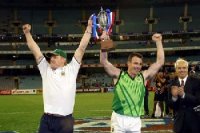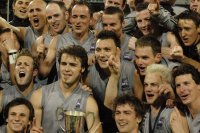Long term view to IC2008 - part one
- Thursday, September 07 2006 @ 01:36 am ACST
- Contributed by: Brett Northey
- Views: 8,190

The 2008 International Cup is just two years away, assuming it will again be held in August. This may seem like a long time but for each country planning on attending their thoughts should already have turned to raising the necessary funds and providing their squads with a quality schedule that will see them playing well come the big tournament. It remains to be seen which nations will show and whether the AFL will be able to significantly subsidise travel, but the hard-working volunteers across the various leagues will no doubt be doing their sums on the basis that they will have to foot the whole bill. We talk to some of the likely attendees, discuss their early preparations, and perhaps foolishly make some early predictions.
 2002 - Ireland |  2005 - New Zealand |  2008 - ? |
The Big Two
New Zealand and Papua New Guinea, along with Ireland, have been the dominant sides in international Aussie Rules. Both have strong junior programs, with the Papuans turning out great junior players through their terrific pathways program with AFL Queensland. Deliberately fielding a very young side at the last Cup, it was merely a sneak peek at the wave of talent coming through. With more mature bodies covering for a lack of key position players and with a few more guns with experience in Australian leagues, the two times runners-up should be in a position to field the best squad yet seen at international level (given that Australia does not play). AFL PNG's Scott Reid: "I have no doubt our kids will be better by 2008, just because there will be more of them progressing through and those who played in 2005 will be 3 years older, stronger, smarter and many will have benefitted of course from exposure here (in Australia). Obviously we struggle to find blokes 6ft 6, but that will not change. In many respects footy might have made big slow blokes redundant when 2008 comes around. Expect PNG to model itself on the (Western) Bulldogs style of play and just play better to our strengths - running". However Reid emphasises that PNG footy is focussed on junior development and pathways and Cup success is just a good outcome that results. "The reality for us is we are totally focussed on progressing our Development Programs and our Talent Pathway with AFLQ. In truth, we have not even thought about 2008. The International Cup, whilst fun to participate in, is really not a high priority for us. By focussing our atttentions on our Talent pathway and juniors up to the Under 18 level and high level Scholarships thereafter the International Cup will basically look after itself. This was the attitude we took in 2005 and will be the same again. We are much more interested to ensure we get our best players showcased through the AFLQ Talent Programs than worrying about the Cup in 2008".
On the other hand the Kiwis continue to have a successful school program and some of the stronger leagues outside of Australia. Undefeated in Melbourne last year they will again be tough to beat. Importantly they've had the chance to play together recently in the Australian Country Championships, and this kind of exposure would be where they'd seek to gain an edge.
The Gaelic Riddle
Predicting the form of the Irish is near impossible. Undefeated for several years with a mixture of talent from different sporting backgrounds, the Green Machine (or the Warriors as their Gaelic moniker was translated) failed to get their fluid running game going for the second Cup. With classy Gaelic footballers always a chance to qualify, the sky is the limit. But with a tiny home league and clubs coming and going, Ireland could finish anywhere from first to outside the top six. Holding the home league together over the next two years will be crucial.
Rising Stars
The United States were improvers between 2002 and 2005 and should build further by 2008. A few new clubs continue to spring up each year, but more importantly most of the existing ones remain, often expanding to include 2 to 6 metro league sides. This widening of the player pool should see more athletic Americans coming through with more experience. Right on their hammer will be the AFL's major international project in South Africa. Booming junior numbers and exchange tours between them and indigenous Australian teams spell a big future. One doubt remains, which is whether the depth will be ready by the next Cup. Even local travel expenses are difficult to cover for the mainly black players, so regular senior competition is scarce. This will be corrected when the juniors translate into local adult leagues, but that hasn't happened yet. The 2005 squad also relied on recently converted white players with Rugby backgrounds for key position size, so this will be needed again to threaten the top three.
Rising Sun
The tenacious and skilful Japanese side often looked impressive last time out, but at the end of the day their smaller bodies saw them struggle. Small players can be top footballers, but just about every successful side has big men in key positions. Whether the Samurai can overcome that through sheer quality or recruitment remains to be seen. Numbers are promising and their two stars in Michito Sakaki and Tsuyoshi Kase are currently gaining valuable experience in Australia, so some modest improvement on the ladder could be hoped for next time around.
Dark Horse Danes
First up strong performers but no shows last year, the Scandinavians will be fascinating. They certainly intend returning to stamp their mark on the footy world, and should be well prepared, as recently reported on WFN by Ian Hill: "Fund raising and planning is already underway to ensure the best possible preparation and a well-organized tour to Australia in 2008". With a long established junior program dominated by Farum in Copenhagen, the Vikings can be expected to field a strapping side that should challenge all but the top couple of teams, and perhaps even those. Denmark will be one to watch.
Neck and Neck
Great Britain and Canada have followed similar paths at International Cups. The Bulldogs have finished 6th at both tournaments, whilst the Northwind came in a bit lower at 9th and 7th. In their final minor round match last year they were locked together in a dour struggle before Britain sealed their win. Both nations feature fairly strong leagues and are slowly introducing more locals to the game. Junior development is yielding good youngsters but 2008 may be too soon for them. As with last time improvement is expected but climbing the rankings is as tough as ever as most countries continue to grow the game. There had been some rumours of Britain splitting into England and Scotland, but with the latter working closely with the BARFL and still only small in number there was never any intention to separate at this early stage of footy's development there. SARFL representative Andy Butler told WFN that a natural evolution to individual English, Scottish and Welsh teams may occur oneday, but no time soon. "As Scots we are a very patriotic bunch and there is always a desire from our local players to play under the Scottish name (i.e. Scottish Puffins) however, considering the expense and current size of our league it is not seen as viable that we could support a national team to attend the International cup in 2008, we will continue to play in national competitions as Scottish Puffins, and our players are eligible to play for the British Bulldogs".
The other Bulldogs, Samoa, are in much the same boat, always a tough competitor but not quite the depth to fight into the top spots. Predicting their form is made more difficult by the number of players they have in Australia who may or may not qualify, depending on when they arrived.
Tough Ask
The more sides at the 2008 AFL International Cup the better, but at this early stage it has to be asked how likely Nauru and Spain are to make it. The former is a small island with a population of only 13000. With a failing economy the team were inconveniently late withdrawals in 2005. It would be sad if they were missing next time, especially given the year marking the nominal 150th anniversary of Australian Football, and Nauru's place as the only other country in the world to so far have embraced the sport as much as Australia (perhaps even more). Many countries would like AFL assistance to contest the next Cup, but perhaps the AFL can make a special case to get them to Melbourne for such an historic occasion.
The other previous contenders we'd raise a question over are Spain. The game there appears to be split between the capital Madrid and the Catalonian region, whose capital is Barcelona. We'll stay right out of this one, but with the AFL only ever likely to invite recognised national teams, hopefully the two sides can work together. This is accentuated by Spain mainly being drawn from Madrid in 2005, and no obvious signs of expansion since then. It would be a big ask for the majority of the players to front again, and indeed improve their ranking.
In part two we'll look at possible new contenders and how all the teams might fair.
Footnote: The Cup shown for 2008 is not the actual design.


 RSS news
RSS news Twitter
Twitter Facebook
Facebook